To see in Monghidoro
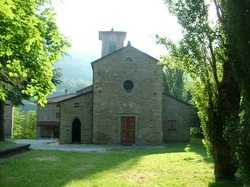
Church of St. Andrea Val di Savena
The original building dates back to 1315, but the church was completely rebuilt in exposed stone in 19th cent. Though there is no rest of the original building, it is one of the most peculiar churches of the area, destination of many religious tours.
The original building dates back to 1315, but the church was completely rebuilt in exposed stone in 19th cent. Though there is no rest of the original building, it is one of the most peculiar churches of the area, destination of many religious tours.
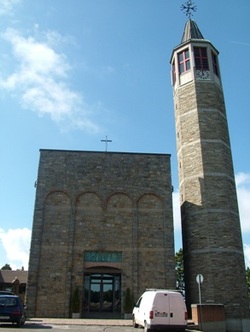
Church of Santa Maria Assunta
The church dedicated to St. Maria Assunta reconstructed in stone in 1951 on the project of the architect Vignali. An octagonal belltower was added in 1991. For both buildings was used the local sandstone. Inside the church there are some interesting paintings including, the Virgin with Saints, an oil painting by the painter A. Burrini; a Virgin with the Child, an oil painting on copper by J. A. Calvi.
The church dedicated to St. Maria Assunta reconstructed in stone in 1951 on the project of the architect Vignali. An octagonal belltower was added in 1991. For both buildings was used the local sandstone. Inside the church there are some interesting paintings including, the Virgin with Saints, an oil painting by the painter A. Burrini; a Virgin with the Child, an oil painting on copper by J. A. Calvi.
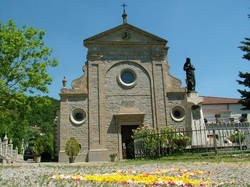
Church of Campeggio
The church dedicated to St. Prospero was completely restored between 1884 and 1888, but there is evidence of the original building named amongst the churches of the 14th cent. The bell tower was built at the end of 18th cent. Inside there is a reproduction of the grotto of Lourdes wanted by Father Augusto Bonafè in 1923. After the violent earthquake in 2003, which also caused damages to the church, it was restored and made safer for pilgrims and believers of this mountain area.
The church dedicated to St. Prospero was completely restored between 1884 and 1888, but there is evidence of the original building named amongst the churches of the 14th cent. The bell tower was built at the end of 18th cent. Inside there is a reproduction of the grotto of Lourdes wanted by Father Augusto Bonafè in 1923. After the violent earthquake in 2003, which also caused damages to the church, it was restored and made safer for pilgrims and believers of this mountain area.
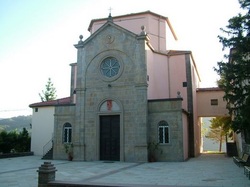
Church of Fradusto
The church dedicated to S. Procolo, early mentioned in 14th cent., was completely reconstructed in 1905 and restored in 1954 after the bombs of the second world war.
The church dedicated to S. Procolo, early mentioned in 14th cent., was completely reconstructed in 1905 and restored in 1954 after the bombs of the second world war.
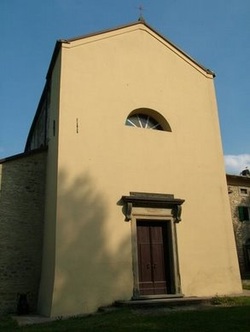
Church of Lognola
The church had different restorations throughout the centuries, in 1687, in 1733, in 1845 and lastly in 2007. Early evidences of the original parish church date back to the 14th cent. Besides to some furnishings it is remarkable a polychrome sandstone bas-relief of the 16th century figuring a Christ lying between the Virgin, Mary Magdalene and Nicodemo (the work is now kept in the Museum of the Church).
The church had different restorations throughout the centuries, in 1687, in 1733, in 1845 and lastly in 2007. Early evidences of the original parish church date back to the 14th cent. Besides to some furnishings it is remarkable a polychrome sandstone bas-relief of the 16th century figuring a Christ lying between the Virgin, Mary Magdalene and Nicodemo (the work is now kept in the Museum of the Church).
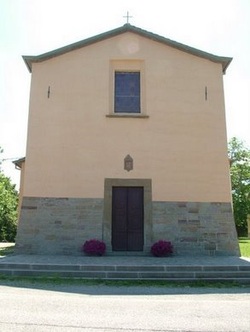
Sanctuary of Madonna dei Boschi
Built in 1687 by the brothers Giovanni and Simone Prosperi it has some works worth of value. To be mentioned the picture figuring the miraculous Virgin of St. Luke and two statues representing the saints Peter and Paul, a sculpture made by the local artist Antonio Gambarini (second half of 18th cent.-1787). In 2002 the organ was repaired by Gastone Mezzaroba, financed by Municipality funds and by the Carisbo Foundation. Its sound enhances the excellent acoustics of the Sanctuary, also placed in a prevailing location on the ridge.
Built in 1687 by the brothers Giovanni and Simone Prosperi it has some works worth of value. To be mentioned the picture figuring the miraculous Virgin of St. Luke and two statues representing the saints Peter and Paul, a sculpture made by the local artist Antonio Gambarini (second half of 18th cent.-1787). In 2002 the organ was repaired by Gastone Mezzaroba, financed by Municipality funds and by the Carisbo Foundation. Its sound enhances the excellent acoustics of the Sanctuary, also placed in a prevailing location on the ridge.
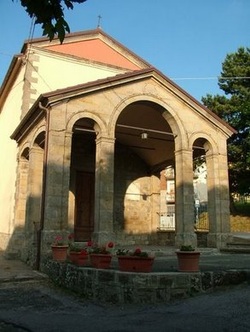
Sanctuary of Piamaggio
In 1893 Mgr. Giuseppe Frati made it built and put a picture of the Virgin of Pompei. Thus, when it was entitled as Sanctuary in 1901, and later as parish church, it had a double name, dedicated to St. Lawrence and to the Virgin of Pompei. Inside it keeps a painting by Sante Nucci figuring the Virgin of the Rosary.
In 1893 Mgr. Giuseppe Frati made it built and put a picture of the Virgin of Pompei. Thus, when it was entitled as Sanctuary in 1901, and later as parish church, it had a double name, dedicated to St. Lawrence and to the Virgin of Pompei. Inside it keeps a painting by Sante Nucci figuring the Virgin of the Rosary.
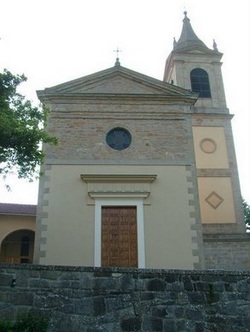
Church of Valgattara
Dedicated to St. Bartolomeo, probably its name reminds the ancient castle of Valgattara, mentioned in 1297, whose ruins are located nearby. In 1688 the church badly damaged was restored and lost most of its works.
Dedicated to St. Bartolomeo, probably its name reminds the ancient castle of Valgattara, mentioned in 1297, whose ruins are located nearby. In 1688 the church badly damaged was restored and lost most of its works.
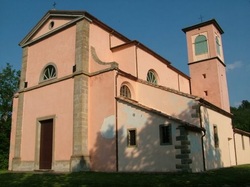
Church of Vergiano
Dedicated to St. Alexander the Pope, the church was founded on the ruins of the old rock of Vergiano, following the tradition. The earliest evidences of the building date back to the year 1300. The bell tower used to keep three old bells, up to the 19th cent. One of the bells was fused by the master Rolando in 1382.
Dedicated to St. Alexander the Pope, the church was founded on the ruins of the old rock of Vergiano, following the tradition. The earliest evidences of the building date back to the year 1300. The bell tower used to keep three old bells, up to the 19th cent. One of the bells was fused by the master Rolando in 1382.
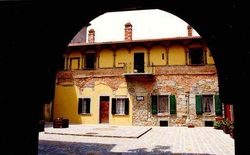
Cloister of The cistern
Relics of the old convent of St. Michele ad Alpes, started in 1528 on commission of the soldier Armaciotto De’ Ramazzotti. The convent, costed 8000 gold ducats, was run by the Olivetan Benedictine monks, up to 1797. Recently restored.
Relics of the old convent of St. Michele ad Alpes, started in 1528 on commission of the soldier Armaciotto De’ Ramazzotti. The convent, costed 8000 gold ducats, was run by the Olivetan Benedictine monks, up to 1797. Recently restored.
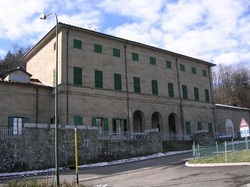
Customs house of Filigare
In the vicinity of the site of Filigare it stands the old customs between the Papal States and the Grand Duchy of Tuscany. Municipality has restored the small pillars, evidence of the ancient border that gives its name to our bed & breakfast.
In the vicinity of the site of Filigare it stands the old customs between the Papal States and the Grand Duchy of Tuscany. Municipality has restored the small pillars, evidence of the ancient border that gives its name to our bed & breakfast.
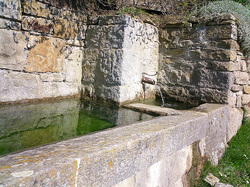
Historical villages
Groups of typical country houses built in sandstone, drawn from the local caves. They are evidence of a country culture no more existing and typical example of an unspoiled architecture of the mountain area.
It is to be mentioned the variety of buildings, strictly related to their territory, divided into many settlements, including four parish churches.
The valley of Idice river (Idex Flumen in the Roman age) includes the hamlet of Campeggio, divided in other villages (Pergoloso, Vincareto and others), Frassineta, Pallerano, Gragnano and Ampugnola. Other villages are also in the Savena valley.
Groups of typical country houses built in sandstone, drawn from the local caves. They are evidence of a country culture no more existing and typical example of an unspoiled architecture of the mountain area.
It is to be mentioned the variety of buildings, strictly related to their territory, divided into many settlements, including four parish churches.
The valley of Idice river (Idex Flumen in the Roman age) includes the hamlet of Campeggio, divided in other villages (Pergoloso, Vincareto and others), Frassineta, Pallerano, Gragnano and Ampugnola. Other villages are also in the Savena valley.
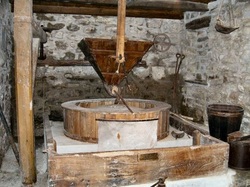
Water mills
The large number of mills located along the Savena and Idice rivers was due to the constant supply of water. Their source of streams was related to the rainfalls of the area, heavier in autumn and spring, causing sudden and wild floods.
The several lateral streams of the two rivers allow a higher capture of the rainfalls, carried abundantly towards the main valleys. Another water supply for the mills was brought from the several perennial springs which run naturally up to the water deposits, especially in the most arid periods, before going into the aqueducts.
The mill factory used to work as follows. The water, necessary for the mill, was diverted by a barrier on the stream, to be channeled and collected in a sort of tank, called “barrel”.
Sometimes the channel was a few hundreds meter long, dug into the ground or made of a brickwork edge, with a slight slope (1-2%) reducing the water speed. This does not erode the ground, but rather allows the sedimentation of mud and sand in suspension.
Usually delimited by brick-work or by soil banks the barrel with its bottom inclined to the mill is a real water supply. It keeps steady the gap between the water level and the water wheel, as well as the milling power, thanks to its continuous input from the channel. One side of the barrel is usually made of a wall connecting with the room where are the bowl wheels, which open in the same wall vaulted underground passages, called “trumpets”, in equal number as the mills. These narrow from outside to inside ending up with a wooden mouth provided with a shatter. When mills were on very steep locations or on different levels lowering to the stream, there was only one ‘trumpet’ to open the barrel and let water pass winding the mills in succession one after the other.
All mills located in the area of Monghidoro are provided with a horizontal water wheel, to suit a limited water supply. The wheel is made of a oak wood roller tapering to the top and with a dozen of “basins” to the bottom, combined radially. At the top of the wheel a transmission bar is inserted, whereas in the lower part a steel pin is fixed, which if set in the proper place into a bronze parallelepiped, so-called ‘bronzina’, allows the system to work without friction. The ‘bronzina’, fitted into a oak parallelepiped placed into a cavity of the base, holds the whole hydraulic motor. This is made of a beam, called ‘banchina’, connected at its end to the building and on the other side to a metal rod, which reaches the mills through a hole in the floor. The ending part has a large bolt resting on a fixed stone, that spinned or unscrewed allows to rais or pull down the ‘banchina’, and consequently the roller of the upper millstone.
The rotation of the hydraulic motor is given by water, so when the mill room opens the pressure flood is released. As for maintenance operations, the ‘threshing’ of the millstone is very important. This restores the perfect trim of the mill surfaces, characterized by triangle shaped grooves and thin rulings, which reduce the friction and favour air circulation, preventing the flour from heating. Most mills in the area of Monghidoro are located along the river of Piattello, coming from different streams at 1000 of height, on the top of the village of Ca’ di Guglielmo. The river forms a small valley defining a triangle plateau of an altitude of 800 m, limited on the west by the Savena river and on the south by the mountain chains of the Tuscan border.
Along the river, over the provincial road passing through Piamaggio and leading to Castel dell’Alpi, there are four mills in succession, a few meters one from the other in Ca’ di Guglielmo, all at an altitude ranging from 860 to 826 m above the sea level. The highest mill is called Ca’ di Guglielmo di Sopra. It is a building on a slope on different floors, with a porch at the entrance and an engraving on an architrave dating back to the mid-18th century. The large barrel, supplied with spring-water, was rebuilt by the Naldi family, who came into possession of the mill in 1910. It was provided with two millstones for grinding different produce, that the miller used to collect door-to-door on his donkey, following an old local tradition. He worked in exchange for flour, instead of money, too little at the time. The three lower mills called of Ca’ di Guglielmo di Sotto are property of the Tedeschi family, who has old origins in the area. The first mill is a unique building on the left bank of the river, whose access goes through a steep cobbled track. The millstones were used for maize, products to livestock and especially for chestnuts. Several were the drying-rooms in Ca’ di Guglielmo, that worked chestnuts even for third parties, from the drying process to the flour manufacturing. The third mill is a humble building also lying on the left bank of the river, 50 m far away from the upper mill. Its small barrel is a unique example of covered barrel in the mills along the Savena river, being covered with beams and soil.
These mills, as the mill valley, have only one millstone, but are of interest for their location in typical small sandstone buildings, well suited to this environment.
Mazzone mill is located at a lower level above sea of 654 m. This is the most interesting mill of Monghidoro for the complexity of its building, the variety of its millstones, the pleasant location and because it is still working. Built before 1785, the building is made of a residence, a stable, different rooms for each millstone and a large porch at the entrance, built in 1878, as it evidences the date engraved on the architrave. A small building, a hundreds m far away, includes an extra millstone, where crops were usually grinded.
This mill, still working, presents all the typical features of this type of factory. A donkey bell on the architrave was used as a burglar alarm beating every time the door was opened or closed. It has left its mark on the door, as evidence of the secular use of the mill.
In 1785 the mill was run by Giacomo and Michele Lorenzini and in 1815 by his son Stefano. In 1872 the mill was run by Galli Domenico was Francesco, in 1906 by Fabbri Alfredo di Domenico and lastly by Galli Antonio (the last miller working full time), whereas the property has now passed to the Sazzini, a family of Piamaggio.
The large number of mills located along the Savena and Idice rivers was due to the constant supply of water. Their source of streams was related to the rainfalls of the area, heavier in autumn and spring, causing sudden and wild floods.
The several lateral streams of the two rivers allow a higher capture of the rainfalls, carried abundantly towards the main valleys. Another water supply for the mills was brought from the several perennial springs which run naturally up to the water deposits, especially in the most arid periods, before going into the aqueducts.
The mill factory used to work as follows. The water, necessary for the mill, was diverted by a barrier on the stream, to be channeled and collected in a sort of tank, called “barrel”.
Sometimes the channel was a few hundreds meter long, dug into the ground or made of a brickwork edge, with a slight slope (1-2%) reducing the water speed. This does not erode the ground, but rather allows the sedimentation of mud and sand in suspension.
Usually delimited by brick-work or by soil banks the barrel with its bottom inclined to the mill is a real water supply. It keeps steady the gap between the water level and the water wheel, as well as the milling power, thanks to its continuous input from the channel. One side of the barrel is usually made of a wall connecting with the room where are the bowl wheels, which open in the same wall vaulted underground passages, called “trumpets”, in equal number as the mills. These narrow from outside to inside ending up with a wooden mouth provided with a shatter. When mills were on very steep locations or on different levels lowering to the stream, there was only one ‘trumpet’ to open the barrel and let water pass winding the mills in succession one after the other.
All mills located in the area of Monghidoro are provided with a horizontal water wheel, to suit a limited water supply. The wheel is made of a oak wood roller tapering to the top and with a dozen of “basins” to the bottom, combined radially. At the top of the wheel a transmission bar is inserted, whereas in the lower part a steel pin is fixed, which if set in the proper place into a bronze parallelepiped, so-called ‘bronzina’, allows the system to work without friction. The ‘bronzina’, fitted into a oak parallelepiped placed into a cavity of the base, holds the whole hydraulic motor. This is made of a beam, called ‘banchina’, connected at its end to the building and on the other side to a metal rod, which reaches the mills through a hole in the floor. The ending part has a large bolt resting on a fixed stone, that spinned or unscrewed allows to rais or pull down the ‘banchina’, and consequently the roller of the upper millstone.
The rotation of the hydraulic motor is given by water, so when the mill room opens the pressure flood is released. As for maintenance operations, the ‘threshing’ of the millstone is very important. This restores the perfect trim of the mill surfaces, characterized by triangle shaped grooves and thin rulings, which reduce the friction and favour air circulation, preventing the flour from heating. Most mills in the area of Monghidoro are located along the river of Piattello, coming from different streams at 1000 of height, on the top of the village of Ca’ di Guglielmo. The river forms a small valley defining a triangle plateau of an altitude of 800 m, limited on the west by the Savena river and on the south by the mountain chains of the Tuscan border.
Along the river, over the provincial road passing through Piamaggio and leading to Castel dell’Alpi, there are four mills in succession, a few meters one from the other in Ca’ di Guglielmo, all at an altitude ranging from 860 to 826 m above the sea level. The highest mill is called Ca’ di Guglielmo di Sopra. It is a building on a slope on different floors, with a porch at the entrance and an engraving on an architrave dating back to the mid-18th century. The large barrel, supplied with spring-water, was rebuilt by the Naldi family, who came into possession of the mill in 1910. It was provided with two millstones for grinding different produce, that the miller used to collect door-to-door on his donkey, following an old local tradition. He worked in exchange for flour, instead of money, too little at the time. The three lower mills called of Ca’ di Guglielmo di Sotto are property of the Tedeschi family, who has old origins in the area. The first mill is a unique building on the left bank of the river, whose access goes through a steep cobbled track. The millstones were used for maize, products to livestock and especially for chestnuts. Several were the drying-rooms in Ca’ di Guglielmo, that worked chestnuts even for third parties, from the drying process to the flour manufacturing. The third mill is a humble building also lying on the left bank of the river, 50 m far away from the upper mill. Its small barrel is a unique example of covered barrel in the mills along the Savena river, being covered with beams and soil.
These mills, as the mill valley, have only one millstone, but are of interest for their location in typical small sandstone buildings, well suited to this environment.
Mazzone mill is located at a lower level above sea of 654 m. This is the most interesting mill of Monghidoro for the complexity of its building, the variety of its millstones, the pleasant location and because it is still working. Built before 1785, the building is made of a residence, a stable, different rooms for each millstone and a large porch at the entrance, built in 1878, as it evidences the date engraved on the architrave. A small building, a hundreds m far away, includes an extra millstone, where crops were usually grinded.
This mill, still working, presents all the typical features of this type of factory. A donkey bell on the architrave was used as a burglar alarm beating every time the door was opened or closed. It has left its mark on the door, as evidence of the secular use of the mill.
In 1785 the mill was run by Giacomo and Michele Lorenzini and in 1815 by his son Stefano. In 1872 the mill was run by Galli Domenico was Francesco, in 1906 by Fabbri Alfredo di Domenico and lastly by Galli Antonio (the last miller working full time), whereas the property has now passed to the Sazzini, a family of Piamaggio.
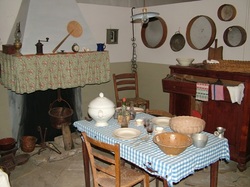
Museum of rural civilization
The Museum of rural civilization of the Apennine is located in the village of Piamaggio, within 3 km from Monghidoro, along the ‘Futa’ road and very near our bed & breakfast (after Ca’ del Costa, turn right on the provincial road leading to Castel dell’Alpi). The curators of the Museum, conceived the Museum based on the space and objects available to give an image of the country life of the time in which visitors are involved. Different environments and sights are shown.
The kitchen, usually on the ground floor, used to heat the house and to cook food, including a chimney. It has a sandstone paving typical of the area, as the original. On one side there is a stone wash-basin with the usual water-pail. The cupboard used to keep all pottery (dishes, bowls, glasses, service etc.), whereas pans, knives and other kitchen tools were usually hanging to be more within reach. Every shelf was used to put most tools. A table, some chairs and a cloack-stand completed the poor furniture.
The bedroom, usually on the upper floor, had a wooden flooring with large cracks for the passage of the heat coming from the underground kitchen.
The bed was made of two wood trestles on which rested some boards supporting a mattress filled with corn leaves (and paion). It was heated with hot embers into a special container, so-called “suora” (nun), which was inside a special support, the so-called “prete” (priest), lifting the sheets preventing them to catch fire. A wash-basin was placed in a corner of the room and the linen and a few wool clothes were kept in a box. In the bedroom usually was included a baby cradle, due to the high birth-rate.
The stable, with a porch sheltering tools, was rebuilt faithfully though in reduced size and it represents the heart of the museum. The hay smell and the lack of animals, used for the hard work in the country, seems to be casual, though you can hear their sounds. Everything shows and recalls the main rural activity which did not always feed the family and their few animals. Tools for the country work and corn manufacturing are mixed with tools used for the collection and transport of fodder.
The school room includes an old desk and a blackboard and faithfully reproduces the old times. On a desk there are original exercise-books, a nib and an old school-bag. A map of Europe is hanging on the wall.
The craft room. The last large room contains a variety of tools used for the traditional works of the rural area of the Apennine, such as tools for working wool and straw, chairs and shoes, iron and wood, ending up with the ones for the wine production.
The mill. Recently, a water mill perfectly working has been built inside the Museum. This 1/3 scale model has been made to show visitors the working of a hydraulic windmill, with the function of the grinding. Outside under the shelter there are some farm equipment.
The Museum is expanding its space with new sections showing the wool and straw working and beekeeping.
The Museum of rural civilization of the Apennine is located in the village of Piamaggio, within 3 km from Monghidoro, along the ‘Futa’ road and very near our bed & breakfast (after Ca’ del Costa, turn right on the provincial road leading to Castel dell’Alpi). The curators of the Museum, conceived the Museum based on the space and objects available to give an image of the country life of the time in which visitors are involved. Different environments and sights are shown.
The kitchen, usually on the ground floor, used to heat the house and to cook food, including a chimney. It has a sandstone paving typical of the area, as the original. On one side there is a stone wash-basin with the usual water-pail. The cupboard used to keep all pottery (dishes, bowls, glasses, service etc.), whereas pans, knives and other kitchen tools were usually hanging to be more within reach. Every shelf was used to put most tools. A table, some chairs and a cloack-stand completed the poor furniture.
The bedroom, usually on the upper floor, had a wooden flooring with large cracks for the passage of the heat coming from the underground kitchen.
The bed was made of two wood trestles on which rested some boards supporting a mattress filled with corn leaves (and paion). It was heated with hot embers into a special container, so-called “suora” (nun), which was inside a special support, the so-called “prete” (priest), lifting the sheets preventing them to catch fire. A wash-basin was placed in a corner of the room and the linen and a few wool clothes were kept in a box. In the bedroom usually was included a baby cradle, due to the high birth-rate.
The stable, with a porch sheltering tools, was rebuilt faithfully though in reduced size and it represents the heart of the museum. The hay smell and the lack of animals, used for the hard work in the country, seems to be casual, though you can hear their sounds. Everything shows and recalls the main rural activity which did not always feed the family and their few animals. Tools for the country work and corn manufacturing are mixed with tools used for the collection and transport of fodder.
The school room includes an old desk and a blackboard and faithfully reproduces the old times. On a desk there are original exercise-books, a nib and an old school-bag. A map of Europe is hanging on the wall.
The craft room. The last large room contains a variety of tools used for the traditional works of the rural area of the Apennine, such as tools for working wool and straw, chairs and shoes, iron and wood, ending up with the ones for the wine production.
The mill. Recently, a water mill perfectly working has been built inside the Museum. This 1/3 scale model has been made to show visitors the working of a hydraulic windmill, with the function of the grinding. Outside under the shelter there are some farm equipment.
The Museum is expanding its space with new sections showing the wool and straw working and beekeeping.
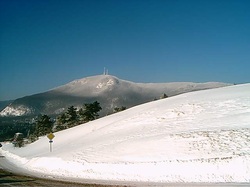
The Alp
The natural reserve of the Alp stretches from the top of the Futa road within two km from the centre of Monghidoro, at short distance from our bed & breakfast, just out the hamlet of Ca’ del Costa turning right going uphill and follow the directions. The area, located at an altitude of 800-1290 m above sea level, is covered by mixed broad-leaved woods, mostly oaks and chestnuts at lower elevations, and beech-trees at higher altitudes. The area is also rich of springs. We suggest you to leave your car by us and walk for a natural tour following well-indicated tracks. There are many rest areas available for picnic and restrooms. Walking through the tops of this area is possible to watch a great variety of birds: the jay, the buzzard, little tits, the little owls, the woodpecker. Among the mammals you can observe the squirrel, the dormouse, the hare. In the early morning or at dusk you can even meet a roe deer, a deer, a wild boar or a fox. Recently there have been wolf sightings in the area. On the clearest days from the top of the mountain Oggioli (1290 m a.s.l.) you can have a great view from the Adriatic sea to the Prealps. Suitable shoes are recommended, though trails are practicable, respect for nature and take back your rubbish with you.
The natural reserve of the Alp stretches from the top of the Futa road within two km from the centre of Monghidoro, at short distance from our bed & breakfast, just out the hamlet of Ca’ del Costa turning right going uphill and follow the directions. The area, located at an altitude of 800-1290 m above sea level, is covered by mixed broad-leaved woods, mostly oaks and chestnuts at lower elevations, and beech-trees at higher altitudes. The area is also rich of springs. We suggest you to leave your car by us and walk for a natural tour following well-indicated tracks. There are many rest areas available for picnic and restrooms. Walking through the tops of this area is possible to watch a great variety of birds: the jay, the buzzard, little tits, the little owls, the woodpecker. Among the mammals you can observe the squirrel, the dormouse, the hare. In the early morning or at dusk you can even meet a roe deer, a deer, a wild boar or a fox. Recently there have been wolf sightings in the area. On the clearest days from the top of the mountain Oggioli (1290 m a.s.l.) you can have a great view from the Adriatic sea to the Prealps. Suitable shoes are recommended, though trails are practicable, respect for nature and take back your rubbish with you.
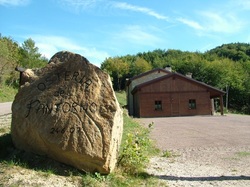
Osteria del Fantorno
The History. The only evidence of the presence of the old building located near the site Ca’ di Fresco, in the direction of Madonna dell’Alpe, called “Osteria del Fantorno”, is through the memory of the past handed down over generations. The memory waned after the desertion of the area due to the population decrease because of a major use of oil replacing wood, the main economical resource. Very recently, the rediscovery of the site of the old inn, renewed interest in searching information of the origins and reasons of its presence in that area. Apparently it was located in such an isolated area, inaccessible from the old roads connecting the cities of Bologna and Florence. Historical references date back to the 18th century and its origins are strictly connected to the local road system of that age. It is generally known that in the early Middle Ages there was a connection between Bologna and Florence passing through the Apennines, exactly on the left bank of the Savena river. This road started from the present Porta S. Stefano in Bologna, winding to the South, going near the Savena river up to the old part of Pianoro to climb up to the villages of Brento, Monzuno, Cedrecchia, the Bastione mountain and the Futa Pass.
Later on some events happened that reduced the importance of this route and necessarily carried out a new road elsewhere. In the early 1200s an important market was set up in the site La Fratta, just outside the town of Loiano going to the south. In 1246 the castle of Scaricalasino (now Monghidoro) was built and consequently the headquarters of the Podestà and of the captain ship. Besides to this, the needs of people to travel for trade resulted in the construction of a new route on the right bank of the Savena river. Nowadays there is no evidence of this route in the area of Monghidoro, though it was well marked just after the end of the second world war. From the town centre of Monghidoro it directed to the cemetery, leading to the village of Piamaggio and then passed just near the site of the Osteria del Fantorno, going through the Alp mountain in the direction of Tuscany. From the information we have it seem that the Osteria del Fantorno, whose name probably comes from one of his manager, was located on the road that connected the cities of Bologna and Florence for many centuries. It provided either refreshment and overnight stay, together with another inn, called “Osteria Bruciata”, located in the Tuscan district near the Futa road, whose foundation are still evident.
It is generally known that travellers passing through this area preferred to stay overnight and leave again the day after, rather than going through the woods at night risking to meet bandits. So it is not true that bandits used to stay at the inn, as some assumed. As regards the road inaccessibility, we know that at those times they used to reduce distances rather than worry about the strong gradients of the roads, as travellers used to go on mules or horses, or on foot too.
Between the years 1800 and 1900 the route probably moved to the present Futa and people were no more obliged to pass through the area of the inn’s location and so it was abandoned. Certainly this was the reason of the end of the Osteria del Fantorno.
In 2007 an important restoration by the Municipality of Monghidoro brought to the construction of a new inn near the site of the old one. The present inn is a departure point for trips to the Alp, walking through those routes which used to connect Northern Europe to Bologna and Florence down to Rome.
The History. The only evidence of the presence of the old building located near the site Ca’ di Fresco, in the direction of Madonna dell’Alpe, called “Osteria del Fantorno”, is through the memory of the past handed down over generations. The memory waned after the desertion of the area due to the population decrease because of a major use of oil replacing wood, the main economical resource. Very recently, the rediscovery of the site of the old inn, renewed interest in searching information of the origins and reasons of its presence in that area. Apparently it was located in such an isolated area, inaccessible from the old roads connecting the cities of Bologna and Florence. Historical references date back to the 18th century and its origins are strictly connected to the local road system of that age. It is generally known that in the early Middle Ages there was a connection between Bologna and Florence passing through the Apennines, exactly on the left bank of the Savena river. This road started from the present Porta S. Stefano in Bologna, winding to the South, going near the Savena river up to the old part of Pianoro to climb up to the villages of Brento, Monzuno, Cedrecchia, the Bastione mountain and the Futa Pass.
Later on some events happened that reduced the importance of this route and necessarily carried out a new road elsewhere. In the early 1200s an important market was set up in the site La Fratta, just outside the town of Loiano going to the south. In 1246 the castle of Scaricalasino (now Monghidoro) was built and consequently the headquarters of the Podestà and of the captain ship. Besides to this, the needs of people to travel for trade resulted in the construction of a new route on the right bank of the Savena river. Nowadays there is no evidence of this route in the area of Monghidoro, though it was well marked just after the end of the second world war. From the town centre of Monghidoro it directed to the cemetery, leading to the village of Piamaggio and then passed just near the site of the Osteria del Fantorno, going through the Alp mountain in the direction of Tuscany. From the information we have it seem that the Osteria del Fantorno, whose name probably comes from one of his manager, was located on the road that connected the cities of Bologna and Florence for many centuries. It provided either refreshment and overnight stay, together with another inn, called “Osteria Bruciata”, located in the Tuscan district near the Futa road, whose foundation are still evident.
It is generally known that travellers passing through this area preferred to stay overnight and leave again the day after, rather than going through the woods at night risking to meet bandits. So it is not true that bandits used to stay at the inn, as some assumed. As regards the road inaccessibility, we know that at those times they used to reduce distances rather than worry about the strong gradients of the roads, as travellers used to go on mules or horses, or on foot too.
Between the years 1800 and 1900 the route probably moved to the present Futa and people were no more obliged to pass through the area of the inn’s location and so it was abandoned. Certainly this was the reason of the end of the Osteria del Fantorno.
In 2007 an important restoration by the Municipality of Monghidoro brought to the construction of a new inn near the site of the old one. The present inn is a departure point for trips to the Alp, walking through those routes which used to connect Northern Europe to Bologna and Florence down to Rome.
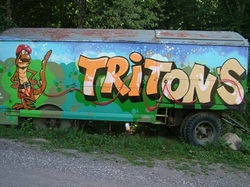
Triton’s Park Adventure
The Triton’s Park Adventure of Monghidoro takes its name from the quaint crested amphibians living in the small lake at the border of the Park, which offers five acrobatic tracks for children and adults.
Seven posts mark the two baby routes, available for children under 4 years and under 140 cm’s tall. The ‘Baby route n. 1’ reaches a maximum height 1.60 m and it is ideal to start playing one’s balance in the air. The ‘Baby route n. 2’, 31 m long, climbs up to 2.30 m from the ground amongst pipes suspended in the air, Nepal bridge, flying bridges made with horizontal boards and other traps. Children are equipped with double security slings and strictly guarded by trainers.
Children over 140 cm’s and adults can choose amongst three tracks with difficulty growing after passing first “The training Path” to become familiar with the security equipment. The Green Path, medium-easy, winds through seven trails for a total length of 55 metres and a maximum height 4.20 m. The Blue path, medium difficult, for 58 m, demands balance and coordination. It starts from the bridge with 3 cables, goes on climbing a single cable, passing oscillating longitudinal trunks, a tricky ladder bridge, moving up on the rope or Tyrolean swings, getting to 7 m from the ground.
More trained participants may try the eight trails of the Red Path climbing from 8 m height up to 10 m using a network of walkways uphill or downhill, swings and lianas.
The lane develops along 80 m closing with a 50 m Tyrolean traverse. Adults with their children can go on playing at tree-climbing, to live a professional climbing experience on the trees.
For opening times please call:
mobile +39 347.8569160 or Tourist Office of Monghidoro +39 051.6555132.
The Triton’s Park Adventure of Monghidoro takes its name from the quaint crested amphibians living in the small lake at the border of the Park, which offers five acrobatic tracks for children and adults.
Seven posts mark the two baby routes, available for children under 4 years and under 140 cm’s tall. The ‘Baby route n. 1’ reaches a maximum height 1.60 m and it is ideal to start playing one’s balance in the air. The ‘Baby route n. 2’, 31 m long, climbs up to 2.30 m from the ground amongst pipes suspended in the air, Nepal bridge, flying bridges made with horizontal boards and other traps. Children are equipped with double security slings and strictly guarded by trainers.
Children over 140 cm’s and adults can choose amongst three tracks with difficulty growing after passing first “The training Path” to become familiar with the security equipment. The Green Path, medium-easy, winds through seven trails for a total length of 55 metres and a maximum height 4.20 m. The Blue path, medium difficult, for 58 m, demands balance and coordination. It starts from the bridge with 3 cables, goes on climbing a single cable, passing oscillating longitudinal trunks, a tricky ladder bridge, moving up on the rope or Tyrolean swings, getting to 7 m from the ground.
More trained participants may try the eight trails of the Red Path climbing from 8 m height up to 10 m using a network of walkways uphill or downhill, swings and lianas.
The lane develops along 80 m closing with a 50 m Tyrolean traverse. Adults with their children can go on playing at tree-climbing, to live a professional climbing experience on the trees.
For opening times please call:
mobile +39 347.8569160 or Tourist Office of Monghidoro +39 051.6555132.
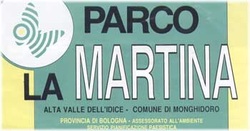
La Martina Park
The Park stretches on a surface of nearly 155 hectares on the right bank of Idice river, mostly made up of flaky sandstone, opposite to the hamlet of Campeggio. It was open by the Province of Bologna in 1972. It is covered mainly by both artificial (coniferous and broad-leaved forestation) and natural woods (mixed broad-leaved forest mostly composed of oaks). The park surface never exceeds a height between 500 and 700 m above sea level. A network of marked routes and paths allow to watch a variety of environments and natural features of the park. Inside the park ruins of an old copper mine can be seen in the vicinity of Gurlano mountain.
The area was once characterized by mostly meadows and arable land and by sparse oak woods. Since the 20s it has been covered by coniferous forest, as Black and Scots pines, white spruce, Lawson Cypress. Amongst broad-leaved forest it has been used a type of oak typical of the vegetation of this region, the Turkey oak. The Park is ideal for walkings and outdoor stops, not far from the Raticosa pass.
Vegetation in La Martina Park
The potential vegetation in La Martina Park is made of mixed broad-leaved forest, mostly composed of local oaks, as Turkey and 'roverella', and other wide-spread tree species, as the Black Carpino, opalo maple (Aceropalus), some Sorbs (Sorbus domesticus, Sorbus torminalis), manna-ash (Fraxinus ornus), etc. In the most fresh and humid areas, besides the most common Turkey oak (Quercus cerris), it can grow the white hornbeam, tree species usually growing in moist deep soils. Pioneer species, as the Black Carpino and manna-ash, have adapted to a thin soil. The 'impluvi', including ditches and streams, are environments favorable to the establishment of vegetation igrofila, as willows and poplars, rather than for the common Black alder (Alnos glutinosa).
Animals of the Park
Rodents are the most representative in the Park, as the common squirrel but also the dormice and the 'quercino'. The hedgehog here finds an ideal habitat. Easy to find are also the fox, the badger, the stone marten, the weasel, the polecat. Several are the ungulates, as the wild boar, the roe deer, uncommon compared to the deer. Richly represented is the avifauna, due to the location and altitude of the Park, favourable to many migratory species, as wood pigeon, goldfinch, chaffinch, thrush, greenfinch. Typical birds and easy to watch are the marsh tit, the coal tit, the red pied and the green woodpeckers, the crow, the raven, the magpie. Among diurnal raptors you can meet the sparrow-hawk, the buzzard and the kestrel. Among nocturnal raptors the little owl, the barn owl, the tawny owl.
The Park stretches on a surface of nearly 155 hectares on the right bank of Idice river, mostly made up of flaky sandstone, opposite to the hamlet of Campeggio. It was open by the Province of Bologna in 1972. It is covered mainly by both artificial (coniferous and broad-leaved forestation) and natural woods (mixed broad-leaved forest mostly composed of oaks). The park surface never exceeds a height between 500 and 700 m above sea level. A network of marked routes and paths allow to watch a variety of environments and natural features of the park. Inside the park ruins of an old copper mine can be seen in the vicinity of Gurlano mountain.
The area was once characterized by mostly meadows and arable land and by sparse oak woods. Since the 20s it has been covered by coniferous forest, as Black and Scots pines, white spruce, Lawson Cypress. Amongst broad-leaved forest it has been used a type of oak typical of the vegetation of this region, the Turkey oak. The Park is ideal for walkings and outdoor stops, not far from the Raticosa pass.
Vegetation in La Martina Park
The potential vegetation in La Martina Park is made of mixed broad-leaved forest, mostly composed of local oaks, as Turkey and 'roverella', and other wide-spread tree species, as the Black Carpino, opalo maple (Aceropalus), some Sorbs (Sorbus domesticus, Sorbus torminalis), manna-ash (Fraxinus ornus), etc. In the most fresh and humid areas, besides the most common Turkey oak (Quercus cerris), it can grow the white hornbeam, tree species usually growing in moist deep soils. Pioneer species, as the Black Carpino and manna-ash, have adapted to a thin soil. The 'impluvi', including ditches and streams, are environments favorable to the establishment of vegetation igrofila, as willows and poplars, rather than for the common Black alder (Alnos glutinosa).
Animals of the Park
Rodents are the most representative in the Park, as the common squirrel but also the dormice and the 'quercino'. The hedgehog here finds an ideal habitat. Easy to find are also the fox, the badger, the stone marten, the weasel, the polecat. Several are the ungulates, as the wild boar, the roe deer, uncommon compared to the deer. Richly represented is the avifauna, due to the location and altitude of the Park, favourable to many migratory species, as wood pigeon, goldfinch, chaffinch, thrush, greenfinch. Typical birds and easy to watch are the marsh tit, the coal tit, the red pied and the green woodpeckers, the crow, the raven, the magpie. Among diurnal raptors you can meet the sparrow-hawk, the buzzard and the kestrel. Among nocturnal raptors the little owl, the barn owl, the tawny owl.
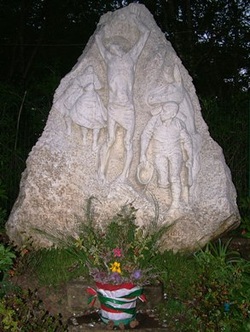
A war memorial to the "penne mozze" (Italian Alpine troops)
This monument made by the sculptor Franco Fiabane of Belluno was unveiled in 1996, on July, 7th. The artist also sculpted the "Virgin shrouded in snow", unveiled by the Pope Giovanni Paolo II in the region of Marmolada. The monument, strongly wished by the Alpine soldiers Group of Monghidoro, was located near the mountain hut in the property donated by the engineer Mariano Tarozzi. The Christ sculpted into the rocks follows the stone outlines as it was crucified in that mountain. The figure is represented squirmed and suffering to show not only the redemption sacrifice but also the suffering of men fighting in the hardship of the mountain. On Christ's right is the Alpine soldier in the act of taking off his hat to show devotion to Christ, with his faithful assistant, the mule.
This monument made by the sculptor Franco Fiabane of Belluno was unveiled in 1996, on July, 7th. The artist also sculpted the "Virgin shrouded in snow", unveiled by the Pope Giovanni Paolo II in the region of Marmolada. The monument, strongly wished by the Alpine soldiers Group of Monghidoro, was located near the mountain hut in the property donated by the engineer Mariano Tarozzi. The Christ sculpted into the rocks follows the stone outlines as it was crucified in that mountain. The figure is represented squirmed and suffering to show not only the redemption sacrifice but also the suffering of men fighting in the hardship of the mountain. On Christ's right is the Alpine soldier in the act of taking off his hat to show devotion to Christ, with his faithful assistant, the mule.
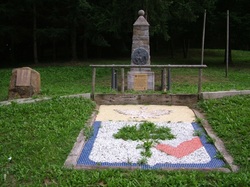
Rimembranze' Park
The Rimembranze' Park is a small but important area located at the northern entrance of the town, at the junction between the 'Futa' road, the SP65, and viale Roma. As the name implies this site is dedicated to memory. A first memorial stone was unveiled in 2003, on April 25th, to commemorate all Italian soldiers fighting on the 'Gothic Line' as allied of the Americans during the last world war.
The medallion put on the stone made by Prof. Luigi Enzo Mattei figures an Italian soldier with an American victim in his arms. Later in 2006, on March 26th, it was open the Park of 'Rimembranze', thanks to the support of Lions Club and of the National Association of Bersaglieri soldiers. It is a unique site in Italy with a plaque as memorial of all Italian soldiers victims all over the world. The list of the victims is probably going to lengthen and to be up-to-dated due to the several Italian Peacekeepers soldiers currently serving all over the world.
The Rimembranze' Park is a small but important area located at the northern entrance of the town, at the junction between the 'Futa' road, the SP65, and viale Roma. As the name implies this site is dedicated to memory. A first memorial stone was unveiled in 2003, on April 25th, to commemorate all Italian soldiers fighting on the 'Gothic Line' as allied of the Americans during the last world war.
The medallion put on the stone made by Prof. Luigi Enzo Mattei figures an Italian soldier with an American victim in his arms. Later in 2006, on March 26th, it was open the Park of 'Rimembranze', thanks to the support of Lions Club and of the National Association of Bersaglieri soldiers. It is a unique site in Italy with a plaque as memorial of all Italian soldiers victims all over the world. The list of the victims is probably going to lengthen and to be up-to-dated due to the several Italian Peacekeepers soldiers currently serving all over the world.
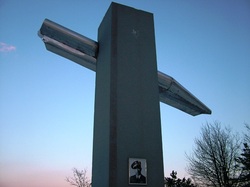
A war memorial to the captain D'Amico
The monument was unveiled in 2005, on September 25th, on the ridge between the towns of Monghidoro and Firenzuola (Tuscany). It was dedicated to the captain D'Amico, a pilot fallen with his plane in this site during the manoeuvres in 1934. At the time a war memorial was made, but it was hidden by brambles and abandoned with its sites for many years, until a group of volunteers decided to carry it out. The monument was restored thanks to both Municipalities and the area was open thanks to many volunteers.
The monument was unveiled in 2005, on September 25th, on the ridge between the towns of Monghidoro and Firenzuola (Tuscany). It was dedicated to the captain D'Amico, a pilot fallen with his plane in this site during the manoeuvres in 1934. At the time a war memorial was made, but it was hidden by brambles and abandoned with its sites for many years, until a group of volunteers decided to carry it out. The monument was restored thanks to both Municipalities and the area was open thanks to many volunteers.
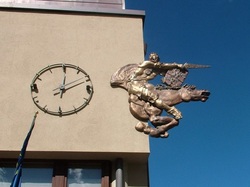
A memorial to Armaciotto de Ramazzotti
The equestrian statue dedicated to the native soldier was unveiled in 2007, on October 7th, during the celebrations of Armaciotto de' Ramazzotti, and on occasion of the first meeting of the Ramazzotti families in Italy. The monument was made by Prof. Luigi Enzo Mattei and located on the main façade of the town hall. The unique and impressive monument is the result of years of study and figures the soldier without helmet on his head to show his valour with his sword unsheathed. His impetuous horse seems one figure with its knight. On the 15th century shield is designed the family's coat of arms, later on representing the town of Monghidoro. The statue is embossed on the town hall wall with the sky in the background. A backgroung changing according to the time and the weather making more suggestive and peculiar the monument.
The equestrian statue dedicated to the native soldier was unveiled in 2007, on October 7th, during the celebrations of Armaciotto de' Ramazzotti, and on occasion of the first meeting of the Ramazzotti families in Italy. The monument was made by Prof. Luigi Enzo Mattei and located on the main façade of the town hall. The unique and impressive monument is the result of years of study and figures the soldier without helmet on his head to show his valour with his sword unsheathed. His impetuous horse seems one figure with its knight. On the 15th century shield is designed the family's coat of arms, later on representing the town of Monghidoro. The statue is embossed on the town hall wall with the sky in the background. A backgroung changing according to the time and the weather making more suggestive and peculiar the monument.

